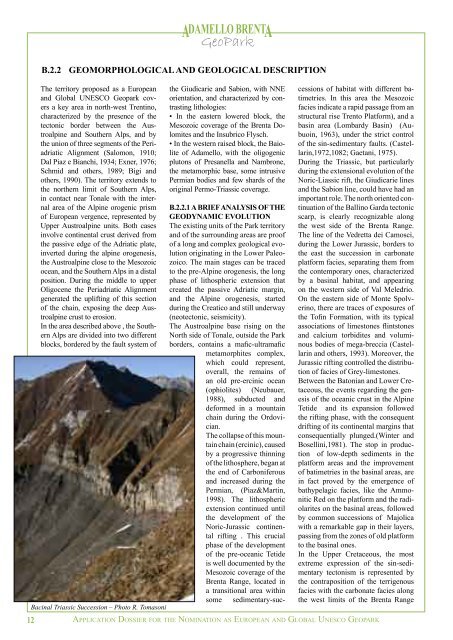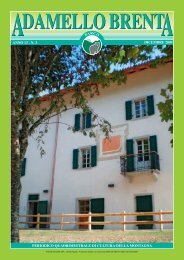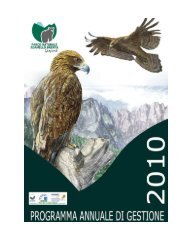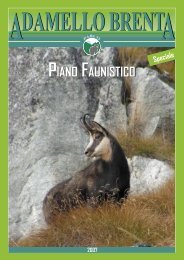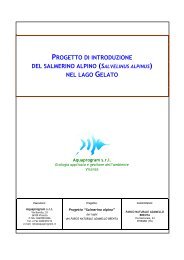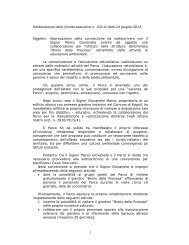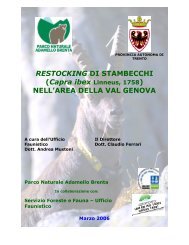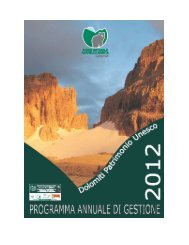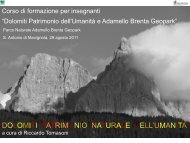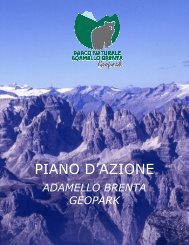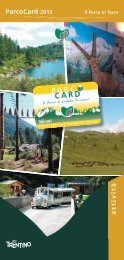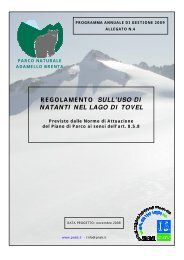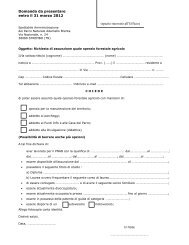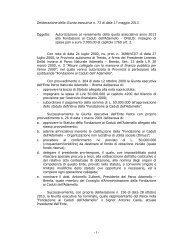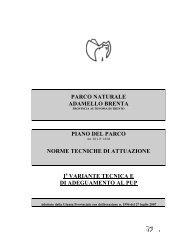DAMELLO BRENT A A - Parco Naturale Adamello Brenta
DAMELLO BRENT A A - Parco Naturale Adamello Brenta
DAMELLO BRENT A A - Parco Naturale Adamello Brenta
You also want an ePaper? Increase the reach of your titles
YUMPU automatically turns print PDFs into web optimized ePapers that Google loves.
12<br />
A <strong>DAMELLO</strong> <strong>BRENT</strong>A<br />
GeoPark<br />
B.2.2 GEOMORPHOLOGICAL AND GEOLOGICAL DESCRIPTION<br />
The territory proposed as a European<br />
and Global UNESCO Geopark covers<br />
a key area in north-west Trentino,<br />
characterized by the presence of the<br />
tectonic border between the Austroalpine<br />
and Southern Alps, and by<br />
the union of three segments of the Periadriatic<br />
Alignment (Salomon, 1910;<br />
Dal Piaz e Bianchi, 1934; Exner, 1976;<br />
Schmid and others, 1989; Bigi and<br />
others, 1990). The territory extends to<br />
the northern limit of Southern Alps,<br />
in contact near Tonale with the internal<br />
area of the Alpine orogenic prism<br />
of European vergence, represented by<br />
Upper Austroalpine units. Both cases<br />
involve continental crust derived from<br />
the passive edge of the Adriatic plate,<br />
inverted during the alpine orogenesis,<br />
the Austroalpine close to the Mesozoic<br />
ocean, and the Southern Alps in a distal<br />
position. During the middle to upper<br />
Oligocene the Periadriatic Alignment<br />
generated the uplifting of this section<br />
of the chain, exposing the deep Austroalpine<br />
crust to erosion.<br />
In the area described above , the Southern<br />
Alps are divided into two different<br />
blocks, bordered by the fault system of<br />
Bacinal Triassic Succession – Photo R. Tomasoni<br />
the Giudicarie and Sabion, with NNE<br />
orientation, and characterized by contrasting<br />
lithologies:<br />
• In the eastern lowered block, the<br />
Mesozoic coverage of the <strong>Brenta</strong> Dolomites<br />
and the Insubrico Flysch.<br />
• In the western raised block, the Baiolite<br />
of <strong>Adamello</strong>, with the oligogenic<br />
plutons of Presanella and Nambrone,<br />
the metamorphic base, some intrusive<br />
Permian bodies and few shards of the<br />
original Permo-Triassic coverage.<br />
B.2.2.1 A BRIEF ANALYSIS OF THE<br />
GEODYNAMIC EVOLUTION<br />
The existing units of the Park territory<br />
and of the surrounding areas are proof<br />
of a long and complex geological evolution<br />
originating in the Lower Paleozoico.<br />
The main stages can be traced<br />
to the pre-Alpine orogenesis, the long<br />
phase of lithospheric extension that<br />
created the passive Adriatic margin,<br />
and the Alpine orogenesis, started<br />
during the Creatico and still underway<br />
(neotectonic, seismicity).<br />
The Austroalpine base rising on the<br />
North side of Tonale, outside the Park<br />
borders, contains a mafic-ultramafic<br />
metamorphites complex,<br />
which could represent,<br />
overall, the remains of<br />
an old pre-ercinic ocean<br />
(ophiolites) (Neubauer,<br />
1988), subducted and<br />
deformed in a mountain<br />
chain during the Ordovician.<br />
The collapse of this mountain<br />
chain (ercinic), caused<br />
by a progressive thinning<br />
of the lithosphere, began at<br />
the end of Carboniferous<br />
and increased during the<br />
Permian, (Piaz&Martin,<br />
1998). The lithospheric<br />
extension continued until<br />
the development of the<br />
Noric-Jurassic continental<br />
rifting . This crucial<br />
phase of the development<br />
of the pre-oceanic Tetide<br />
is well documented by the<br />
Mesozoic coverage of the<br />
<strong>Brenta</strong> Range, located in<br />
a transitional area within<br />
some sedimentary-suc-<br />
cessions of habitat with different batimetries.<br />
In this area the Mesozoic<br />
facies indicate a rapid passage from an<br />
structural rise Trento Platform), and a<br />
basin area (Lombardy Basin) (Aubuoin,<br />
1963), under the strict control<br />
of the sin-sedimentary faults. (Castellarin,1972,1082;<br />
Gaetani, 1975).<br />
During the Triassic, but particularly<br />
during the extensional evolution of the<br />
Noric-Liassic rift, the Giudicarie lines<br />
and the Sabion line, could have had an<br />
important role. The north oriented continuation<br />
of the Ballino Garda tectonic<br />
scarp, is clearly recognizable along<br />
the west side of the <strong>Brenta</strong> Range.<br />
The line of the Vedretta dei Camosci,<br />
during the Lower Jurassic, borders to<br />
the east the succession in carbonate<br />
platform facies, separating them from<br />
the contemporary ones, characterized<br />
by a basinal habitat, and appearing<br />
on the western side of Val Meledrio.<br />
On the eastern side of Monte Spolverino,<br />
there are traces of exposures of<br />
the Tofin Formation, with its typical<br />
associations of limestones flintstones<br />
and calcium torbidites and voluminous<br />
bodies of mega-breccia (Castellarin<br />
and others, 1993). Moreover, the<br />
Jurassic rifting controlled the distribution<br />
of facies of Grey-limestones.<br />
Between the Batonian and Lower Cretaceous,<br />
the events regarding the genesis<br />
of the oceanic crust in the Alpine<br />
Tetide and its expansion followed<br />
the rifting phase, with the consequent<br />
drifting of its continental margins that<br />
consequentially plunged.(Winter and<br />
Bosellini,1981). The stop in production<br />
of low-depth sediments in the<br />
platform areas and the improvement<br />
of batimetries in the basinal areas, are<br />
in fact proved by the emergence of<br />
bathypelagic facies, like the Ammonitic<br />
Red on the platform and the radiolarites<br />
on the basinal areas, followed<br />
by common successions of Majolica<br />
with a remarkable gap in their layers,<br />
passing from the zones of old platform<br />
to the basinal ones.<br />
In the Upper Cretaceous, the most<br />
extreme expression of the sin-sedimentary<br />
tectonism is represented by<br />
the contraposition of the terrigenous<br />
facies with the carbonate facies along<br />
the west limits of the <strong>Brenta</strong> Range<br />
APPLICATION DOSSIER FOR THE NOMINATION AS EUROPEAN AND GLOBAL UNESCO GEOPARK


